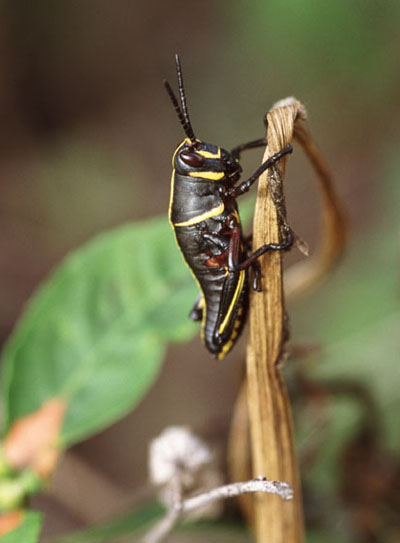 As I mentioned in the previous post, I’m in the middle of updating the galleries of the main website – don’t go rushing over there, since there’s nothing to be seen just yet; I’ll be uploading them all at once when everything’s ready. But among the changes, I’m adding more information to some of the older pics, and one of those is the image at left, of a previously unknown grasshopper found in Florida in 2000. I’d stopped alongside of Rt 41 (Tamiami Trail) in the Everglades to try and spot alligators, which I succeeded in, until they realized I was there (it took about .25 seconds) and they hurtled off the banks of the canal into the water and disappeared. As usual, I began examining the area to make sure that I wasn’t missing something else, and came across a cluster of these insects raiding a discarded soft drink cup. Some of the passing drivers might have thought I was a bit off, sprawled on my belly just off the roadside photographing weeds, but then again it was the Everglades, and it’s far from the strangest thing that takes place therein.
As I mentioned in the previous post, I’m in the middle of updating the galleries of the main website – don’t go rushing over there, since there’s nothing to be seen just yet; I’ll be uploading them all at once when everything’s ready. But among the changes, I’m adding more information to some of the older pics, and one of those is the image at left, of a previously unknown grasshopper found in Florida in 2000. I’d stopped alongside of Rt 41 (Tamiami Trail) in the Everglades to try and spot alligators, which I succeeded in, until they realized I was there (it took about .25 seconds) and they hurtled off the banks of the canal into the water and disappeared. As usual, I began examining the area to make sure that I wasn’t missing something else, and came across a cluster of these insects raiding a discarded soft drink cup. Some of the passing drivers might have thought I was a bit off, sprawled on my belly just off the roadside photographing weeds, but then again it was the Everglades, and it’s far from the strangest thing that takes place therein.
Now, it’s fairly easy to tell this is a small insect, and it went unidentified until last night when I tried again to scare up some mention of this strange coloration. Bugguide.net produced a match, and when I was reading the description I noticed the word “nymph.” That meant the adult probably had a different appearance, so I checked their other images.
Aha! Turns out that I had even more images of this species in my stock, and had in fact captured it on film on my previous trip, that time in the Audubon Society Corkscrew Swamp Sanctuary. It’s an eastern lubber grasshopper (Romalea microptera,) pretty common in Florida.

This image is deceptive, since this was the largest specimen of this class of insect that I’ve ever found, roughly 8-10 cm (3-4 inches) in length and able to carry off chihuahuas. It’s encounters with such things that convince anyone visiting Florida that the state has some special property, stagnating in time from the late Jurassic or maybe just too much uranium, but more likely it’s simply a factor of being in the subtropics.
Then I checked another image I had, from earlier in the same trip, this time at a park somewhere on the Suwanee River. I had arrived in the predawn darkness to see what sunrise on the river would bring, and while that goal was trashed by a boring dawn, the trip back on the trail revealed a monster “locust” that I snagged for some pics. Note the coloration of this one, and realize that it’s in the transitional stage between nymph and adult coloration.

And yes, that’s my wrist that it’s perched on, because I really wanted to show the scale. This isn’t yet adult size – do you get the idea now?
The other thing that the morning light revealed was how many massive spiderwebs I’d walked under on the dark trail to the river. Up to two meters (six feet) across, they remain the largest webs I’ve ever seen and made me very glad I didn’t walk through one in the darkness, because I’m not sure I would have gotten free without William Shatner’s help. But when the grasshoppers get this big, so do the things that eat them I guess, and I’m probably not helping Florida tourism any, unless I’m reaching a lot of entomologists with these posts.



















































